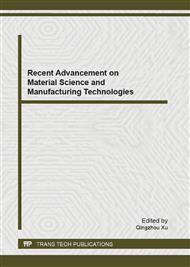p.215
p.219
p.224
p.229
p.233
p.237
p.241
p.252
p.258
Quantum Yield and Curing Velocity of Two α-Hydroxy Ketone Photoinitiators
Abstract:
The quantum yield is an important parameter to evaluate the initiation efficiency of photoinitiators and improve the curing velocity of photocurable materials. In this paper, two α-hydroxy ketone photoinitiators (Darocure1173 and Irgacure184) were studied based on the spectroscopic analysis and photo-initiated theory. Exposure fore-and-aft absorption spectra of samples with different exposure thickness (5mm, 10mm, 15mm, 20mm and 25mm) were measured. Quantum yields were obtained by analyzing the relationship between the exposure thickness and evaluation error. The curing velocity related to different photoinitiator and photoinitiator mass percentage was studied. Results show that quantum yields of Darocure1173 and Irgacure184 are 0.277% and 0.207% respectively at absorption peak (247nm). Optimal proportions of two photoinitiators are 6% and 5% respectively. Darocure1173 is prior to Irgacure184 in curing velocity.
Info:
Periodical:
Pages:
233-236
Citation:
Online since:
July 2013
Authors:
Keywords:
Price:
Сopyright:
© 2013 Trans Tech Publications Ltd. All Rights Reserved
Share:
Citation:


